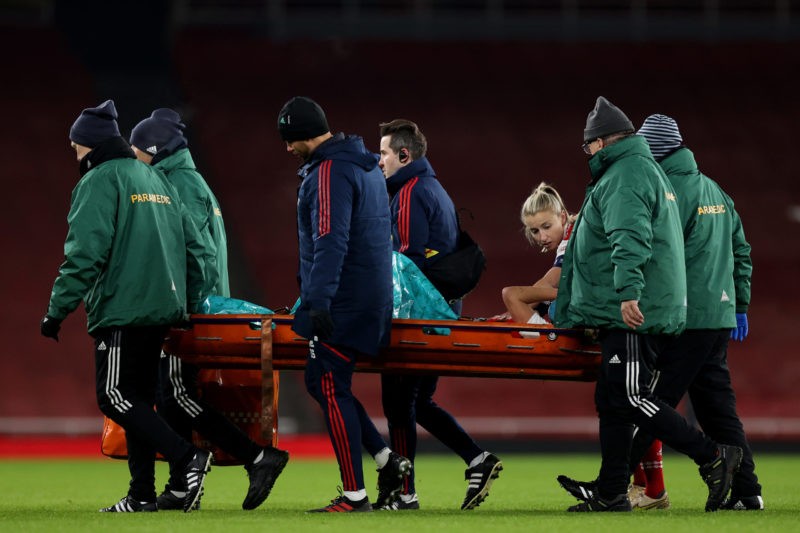As Arsenal crashed out of the Champions League on Monday evening, they lost yet another player to what look like an ACL injury when Laura Wienroither was stretchered off. Given this could be the fourth injury of this type this season, shouldn’t someone be asking ‘what’s going on?’
- Arsenal Women have faced multiple ACL injuries, with Beth Mead, Vivianne Miedema, Leah Williamson, and potentially Laura Wienroither affected.
- Jordan Nobbs called for more research into the connection between menstrual cycles and ACL injuries in 2019, highlighting the significantly higher risk for women.
- Open discussions and further research on this issue can lead to better prevention strategies and support for female athletes.

Beth Mead, Vivianne Miedema, Leah Williamson and now, potentially, Laura Wienroither, have all had their seasons ended early after picking up an ACL injury.
That’s almost half a starting XI with the same injury in the same team.
What could be the connection?
In 2017, a systematic review and meta-analysis of 21 studies, including 68,758 participants, showed that women are at a significantly higher risk for ACL injuries than men.
Speaking in 2019, then-Arsenal Women’s midfielder Jordan Nobbs called for more research into this connection between menstrual cycles and anterior cruciate ligament (ACL) injuries, but we’ve seen little followup.
“Until I got injured, I didn’t really know that a lot of women do it while in their menstrual cycle,” Nobbs told the BBC, adding that her period had begun the morning of her injury.

“I was very tired leading up to that week, and I was on the first day of my menstrual cycle.
“I’m not one for saying it was that, but the facts on how so many women have done their knee and been on their menstrual cycle are very high. I don’t know if it was down to that, but it was a very high factor.”
Oestrogen, which is released during menstruation, can increase joint flexibility according to current research. Previous analysis also found that ACL laxity increased during the ovulatory phase compared to the follicular phase.

However, the overall strength of evidence remains low, and future research directions may include long-term observational studies and large interventional trials incorporating newer hormonal methods.
Conversations about menstrual cycles and their impact on female athletes remain relatively taboo in society and the world of football. However, it’s essential to recognise that if men had to endure a menstrual cycle, it would likely be discussed as openly as any other bodily function.

Around the same time as Nobbs picked up her injury, Dr. Rajpal Brar, a wellness coach and performance specialist from Los Angeles, discussed the issue of ACL injuries in female athletes.
He explained the reasons behind the higher prevalence of ACL injuries in women compared to men and shared insights on how surgery can repair the problem in the video you can see below.
As the issue of ACL injuries in female footballers gains more attention, it’s crucial for clubs like Arsenal and the broader football community to support further research and open discussions on the subject.
By understanding the link between menstrual cycles and ACL injuries, better prevention strategies and support can be provided to female athletes, ultimately enhancing their performance and reducing the risk of career-altering injuries.

